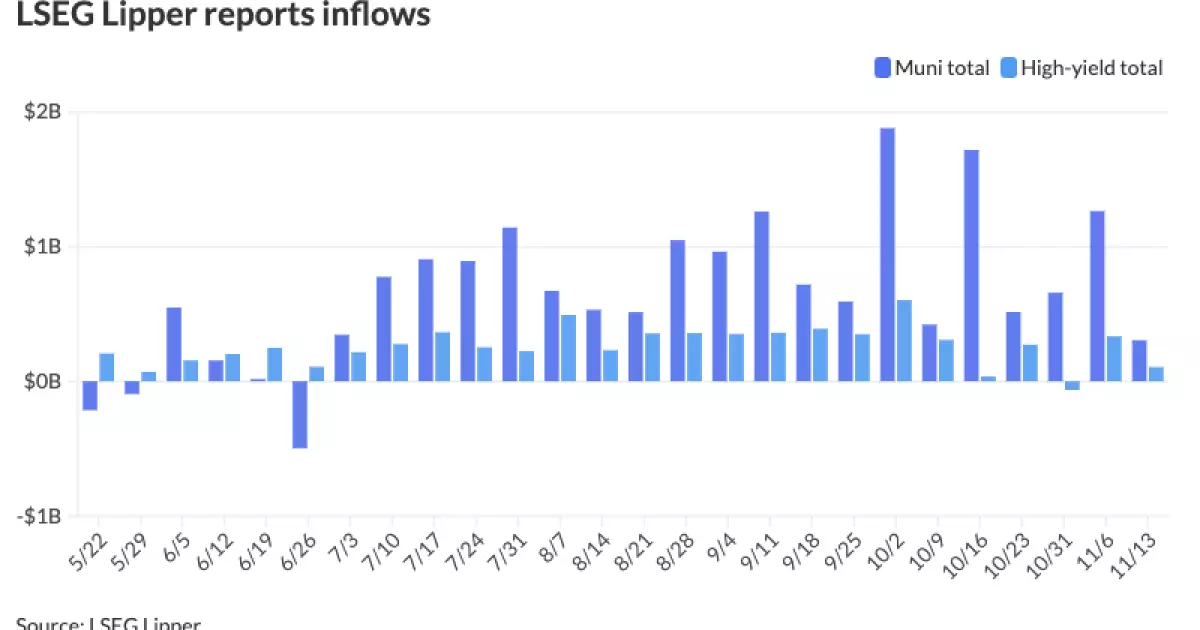The municipal bond market has demonstrated a complex landscape in recent weeks, characterized by mixed results amid shifting economic conditions. As of Thursday, the market displayed a slight divergence in performance, with U.S. Treasuries reflecting losses in the short term while yielding gains over longer durations. This intricate scenario highlights the continued volatility that investors are grappling with, particularly following significant political events such as the recent elections. The aftermath of these events has infused uncertainty into the market, causing yields to fluctuate by as much as three basis points in various segments.
Even with this recent volatility, municipal bonds have maintained a semblance of stability. Experts from BlackRock have indicated that as financial issuance decreases and seasonal dynamics favor stronger performance toward the year’s end, investors may find that municipals hold up well despite fluctuations. This optimistic view is crucial as it provides a counterbalance to the anxiety many feel regarding the economic implications stemming from the elections and Federal Reserve policy decisions.
By drawing parallels to historical trends, the current period bears similarities to the volatility experienced in November 2016. According to Kim Olsan, a seasoned fixed income portfolio manager at NewSquare Capital, the month reflects characteristics similar to 2016, where yields saw significant increases of up to 70 basis points. Observing this historical context gives investors a framework to evaluate current market behaviors and make informed decisions moving forward.
Olsan noted that the changing dynamics of U.S. Treasuries, especially concerning relative values in the municipal bond space, may lead to adjustments in investor flows. Presently, a significant percentage—around 16%—of secondary, tax-exempt trade volumes fall within the 2026 to 2032 maturity range. The absence of 3.00% yield offerings during this critical period has drawn attention and suggests a need for careful monitoring of market developments.
As the market reacts to shifts in benchmarks, the two-year municipal to U.S. Treasury yield ratios have recently settled around 61%. In comparison, the three-year and five-year ratios hover near 60% and 62%, respectively. These figures, shared by Refinitiv Municipal Market Data, reveal how closely intertwined municipal bonds are with Treasuries, and underscore the need for continual assessments of yields in light of prevailing economic conditions.
While the slopes of the yield curve indicate a potential advantage for buyers, with real yields exceeding 3% across a variety of structures, caution remains advisable. Olsan raises valid concerns regarding perceived buyer trepidation, fueled by anticipated supply increases into late 2024. As historically, November and December have produced average total issuances of around $60 billion, recent expectations for issuance could face disruption due to pronounced rate fluctuations.
The sentiment within the municipal market remains mixed, emphasizing the necessity for ongoing vigilance. Despite experiencing inflows for 20 consecutive weeks, the recent weeks have yielded diminished enthusiasm, with the added complexity of a reported $305 million inflow compared to $1.264 billion the week prior. This decline could signify a pivotal shift in investor behavior, especially as high-yield funds reflect contrasting trends, indicating more bullish positioning with inflows of $105.3 million, up from the previous week’s outflows.
As the market prepares itself for potential heavier selling ahead, the factors of bids wanted and fund flows will play crucial roles in influencing yield pressure going forward. A significant determination of market trajectory will rely upon how effectively these trends translate to investor confidence and market stability.
Concurrently, market participants are actively engaging in primary trading activity. Recent transactions include substantial bond pricing for prominent public entities such as the Los Angeles Department of Water and Power and the Omaha Public Power District. These trades reflect both the resilience and strategic pricing approaches necessary within a fluctuating yield environment. With various bonds seeing call features ranging from 2.40% to 4.18%, the market underlines the importance of flexibility and responsiveness amongst investors.
The pricing strategies employed reflect broader market sentiments, where the urgency to capitalize on favorable structures underlines the continual adjustments being made in response to ongoing economic shifts. Those engaged in the municipal bond market must remain astute, adapting their strategies to harness the potential benefits of current dynamics while mitigating inherent risks associated with a climate of uncertainty.
The municipal bond market is situated in a phase of transitional dynamics, swayed by external events and internal economic pressures. With various layers of volatility to consider, investors must work diligently to navigate the evolving landscape while remaining alert to shifts in issuer behaviors and bond performance. The confluence of historical context, market sentiment, and ongoing economic developments will shape the pathways available to municipal bond investors as they chart their course through the remainder of the year. As we approach year-end, understanding these complexities will be vital in leveraging opportunities within this dynamic market.


Leave a Reply